Abstract
OBJECTIVE: The purpose of this study was to initially determine if growth hormone or nutrients, given alone or together, could enhance absorption from the remnant small bowel after massive intestinal resection. If clinical improvement were observed, this therapy would then be used to treat patients with the short-bowel syndrome over the long term. SUMMARY BACKGROUND DATA: Patients who undergo extensive resection of the gastrointestinal tract frequently develop malabsorption and require long-term parenteral nutrition. The authors hypothesized that the administration of growth factors and/or nutrients could enhance further compensation of the remnant intestine and thereby improve absorption. Specifically, animal studies have shown that there is enhanced cellularity with the administration of growth hormone (GH) or glutamine (GLN), or a fiber-containing diet. METHODS: Initially, 17 studies were performed in 15 total parenteral nutrition (TPN)-dependent short-bowel patients over 3 to 4 weeks in the clinical research center; the first week served as a control period, and during the next 1 to 3 weeks, the specific treatment was administered and evaluated. Throughout the study, food of known composition was provided and all stool was collected and analyzed to determine absorption across the remaining bowel. The effect of a high-carbohydrate, low-fat diet (DIET), the amino acid glutamine (GLN) and growth hormone (GH) administered alone or in combination with the other therapies (GH + GLN + DIET) was evaluated. The treatment was expanded to 47 adults (25 men, 22 women) with the short-bowel syndrome, dependent on TPN for 6 +/- 1 years. The average age was 46 +/- 2 years, and the average jejunal-ileal length was 50 +/- 7 cm (median 35 cm) in those with all or a portion of colon and 102 +/- 24 cm (median 102 cm) in those with no colon. After 28 days of therapy, the patients were discharged on only GLN + DIET. RESULTS: The initial balance studies indicated improvement in absorption of protein by 39% accompanied by a 33% decrease in stool output with the GH + GLN + DIET. In the long-term study, 40% of the group remain off TPN and an additional 40% have reduced their TPN requirements, with follow-up averaging a year and the longest being over 5 years. CONCLUSION: GH + GLN + DIET offers a potential method for providing cost-effective rehabilitation of surgical patients who have the short-bowel syndrome or other complex problems of the gastrointestinal tract. This therapeutic combination also may be useful to enhance bowel function in patients with other gastrointestinal diseases and those requiring extensive intestinal operations, including transplantation.
Full text
PDF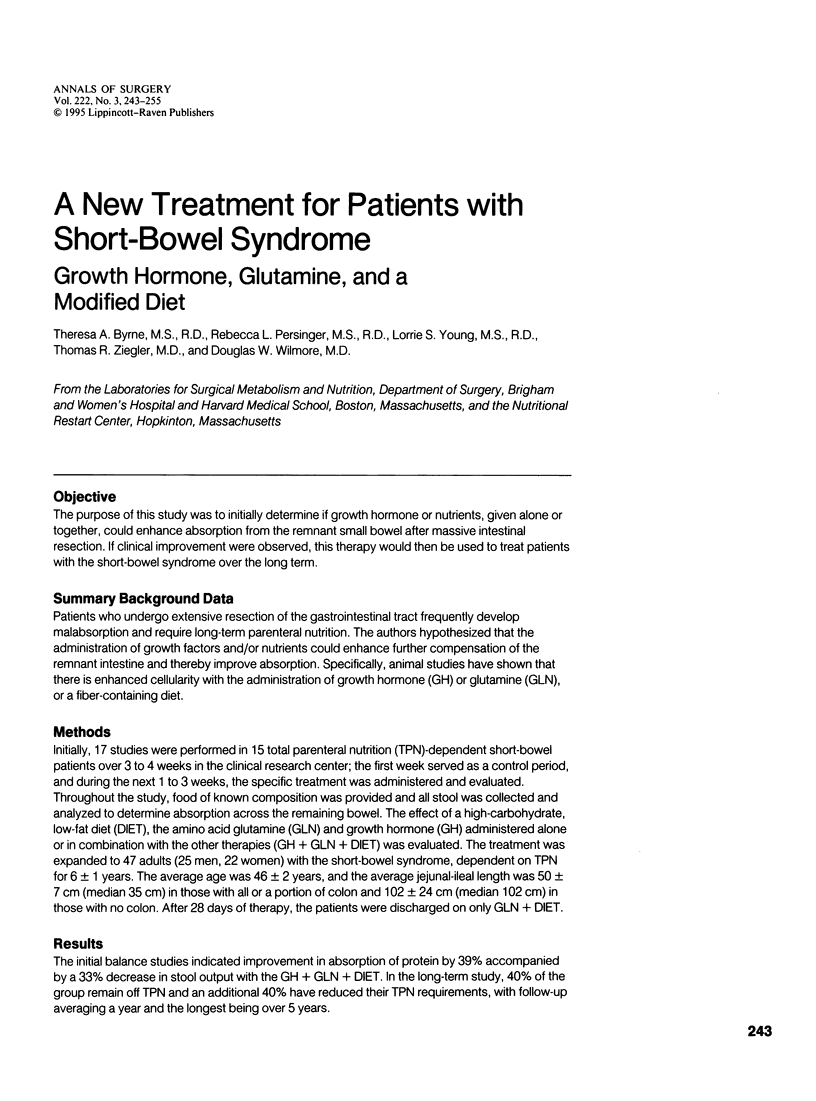
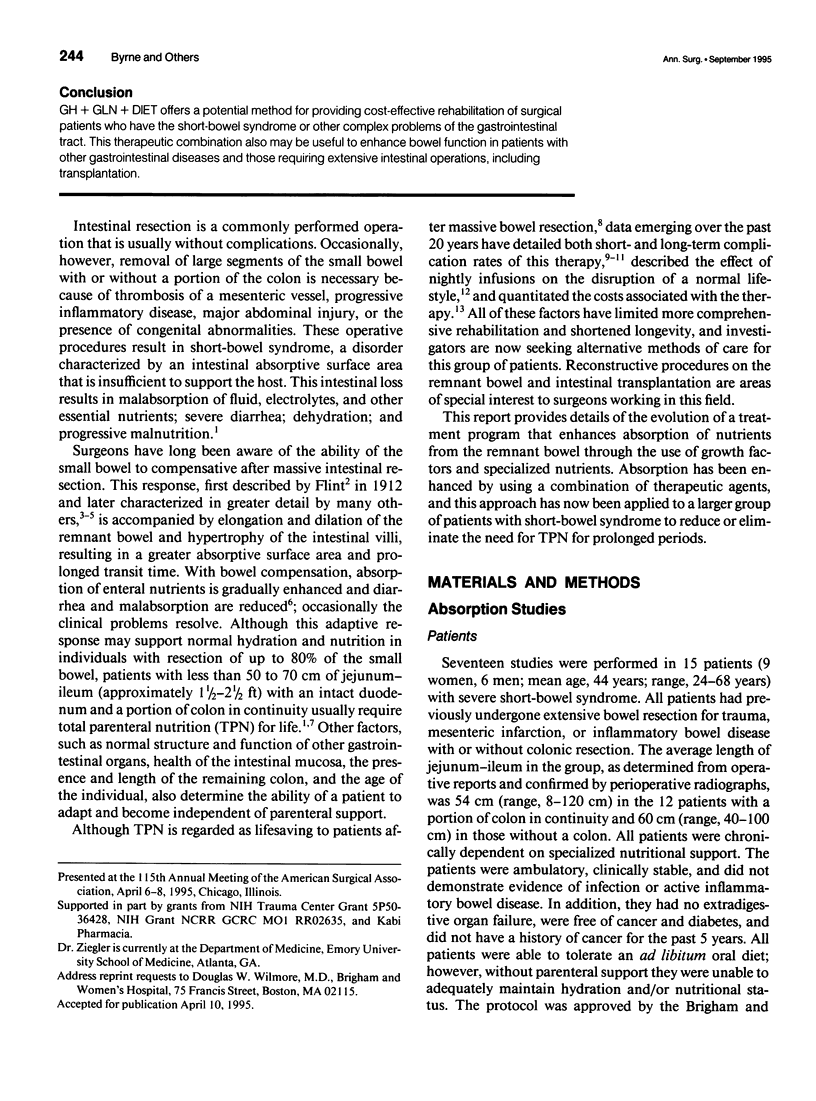
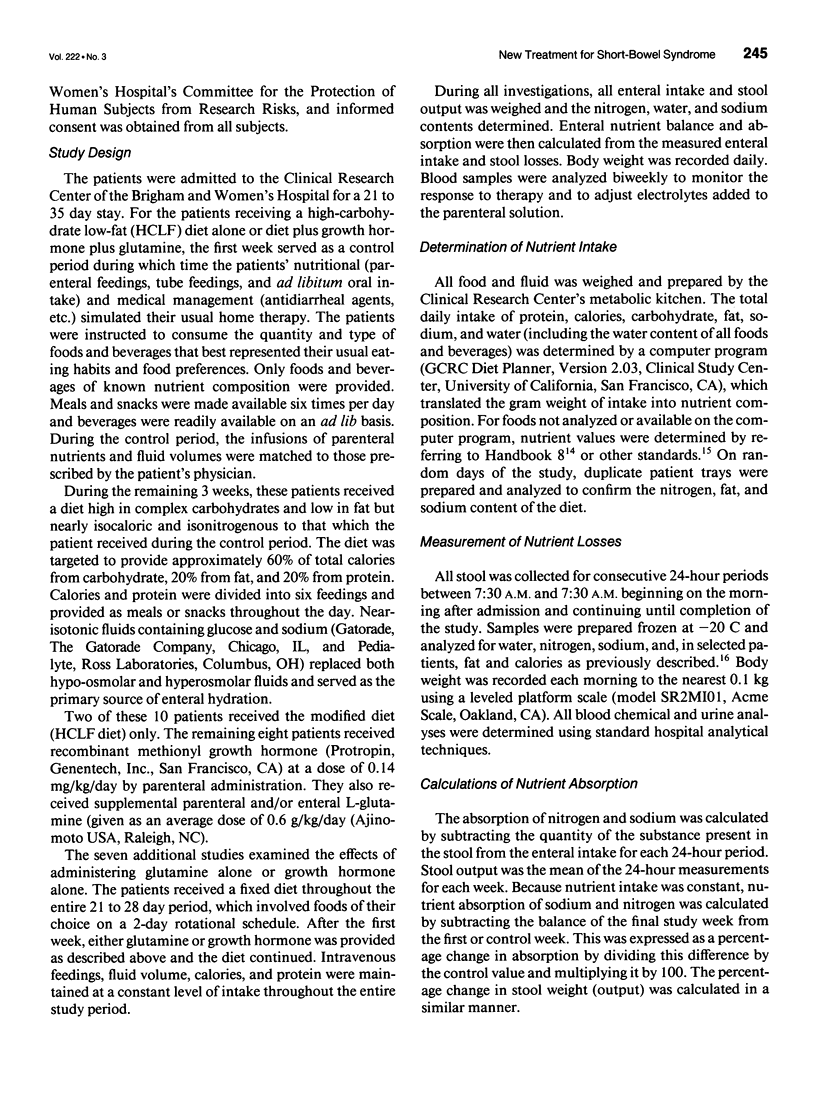


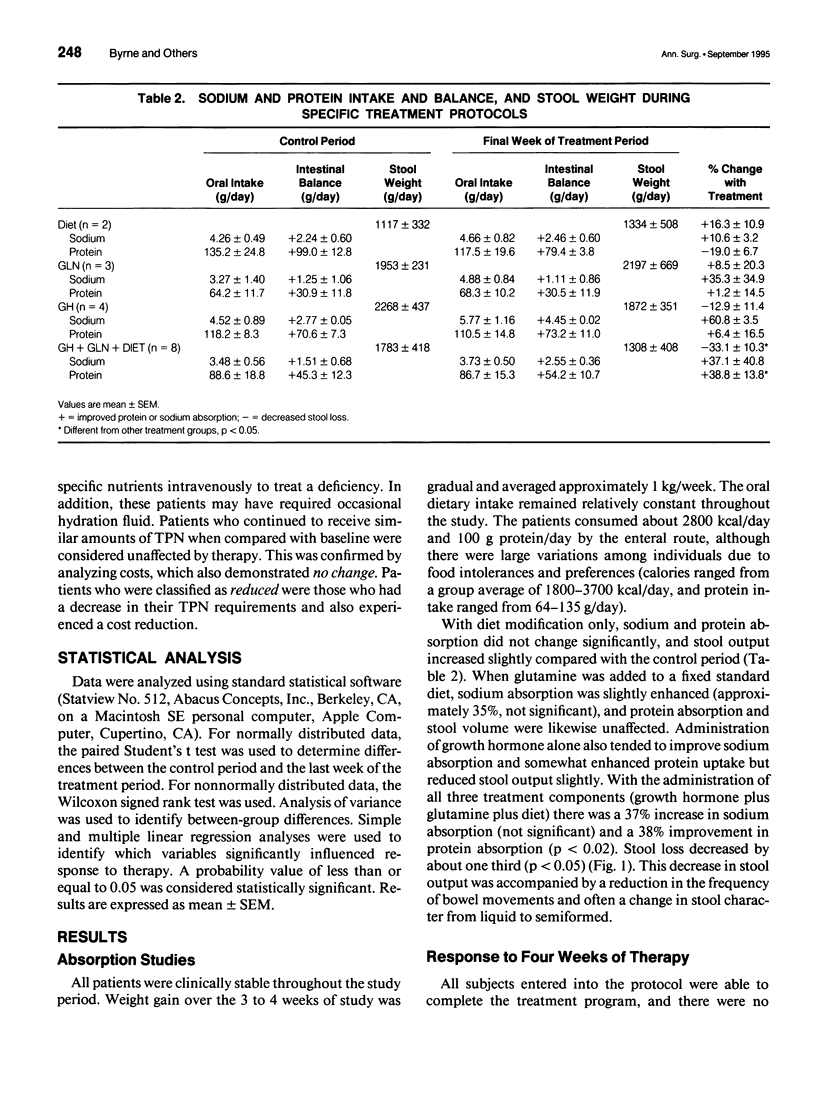
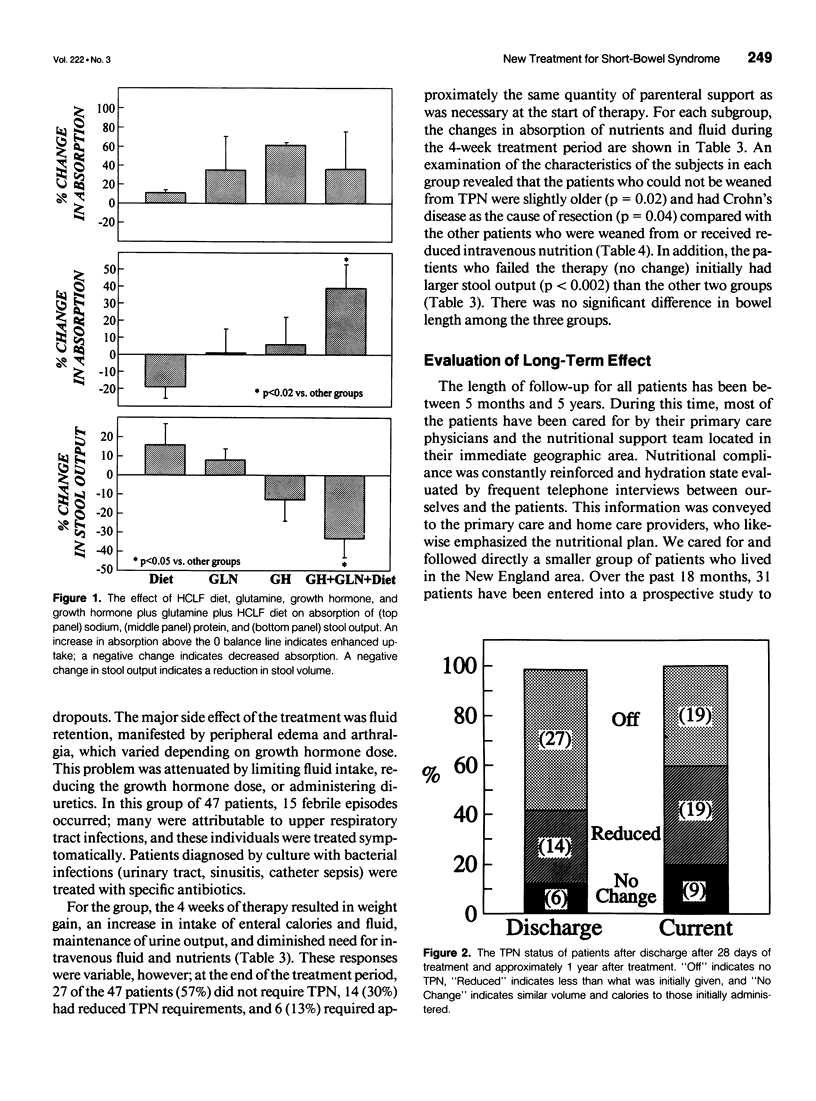
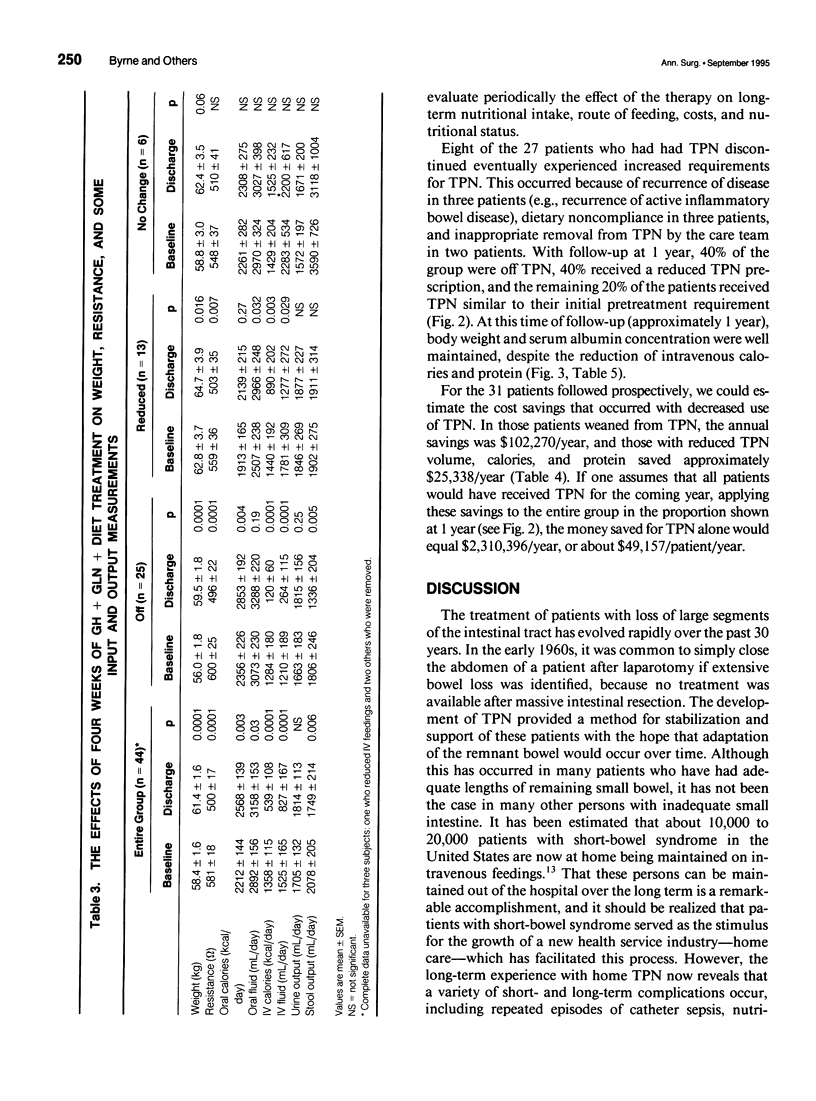
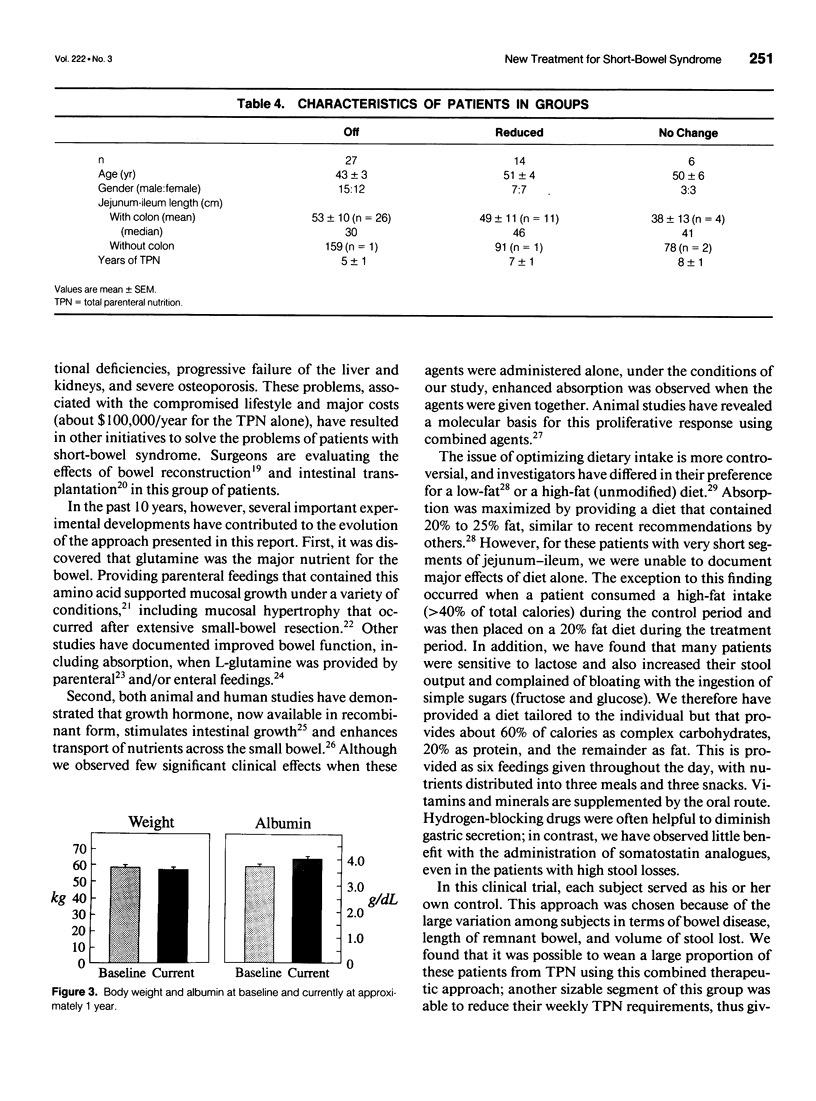
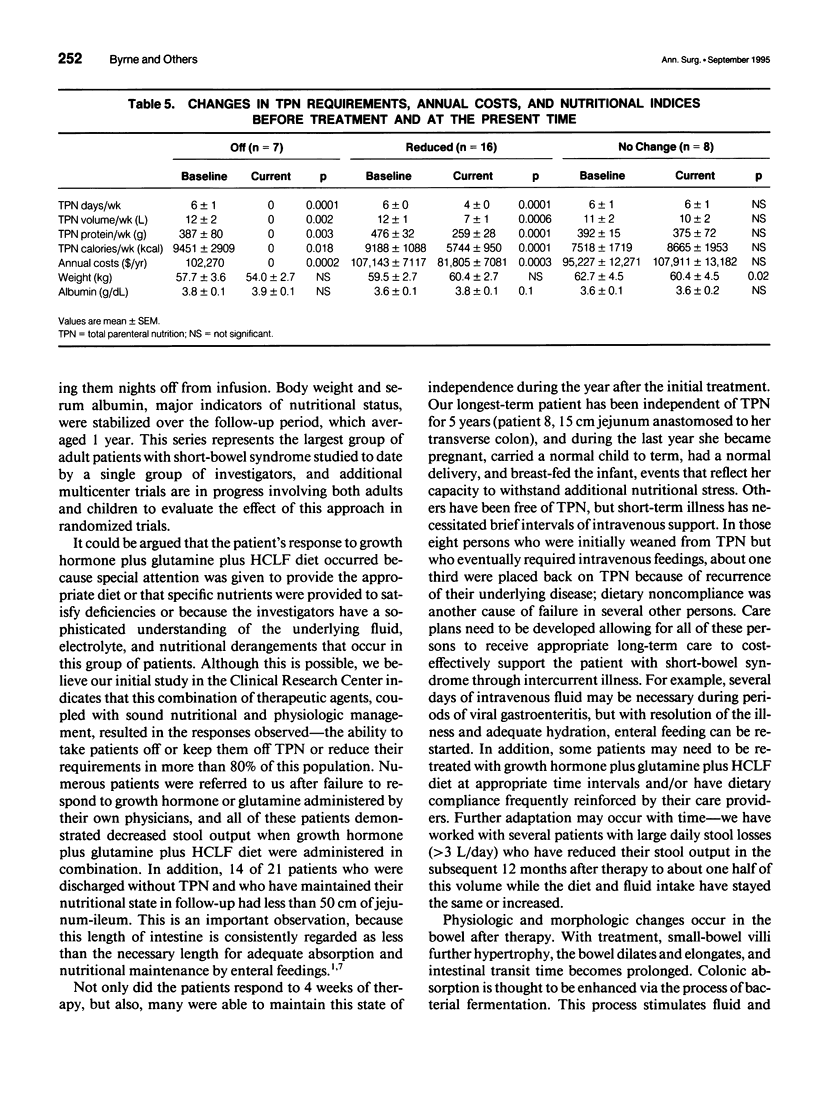
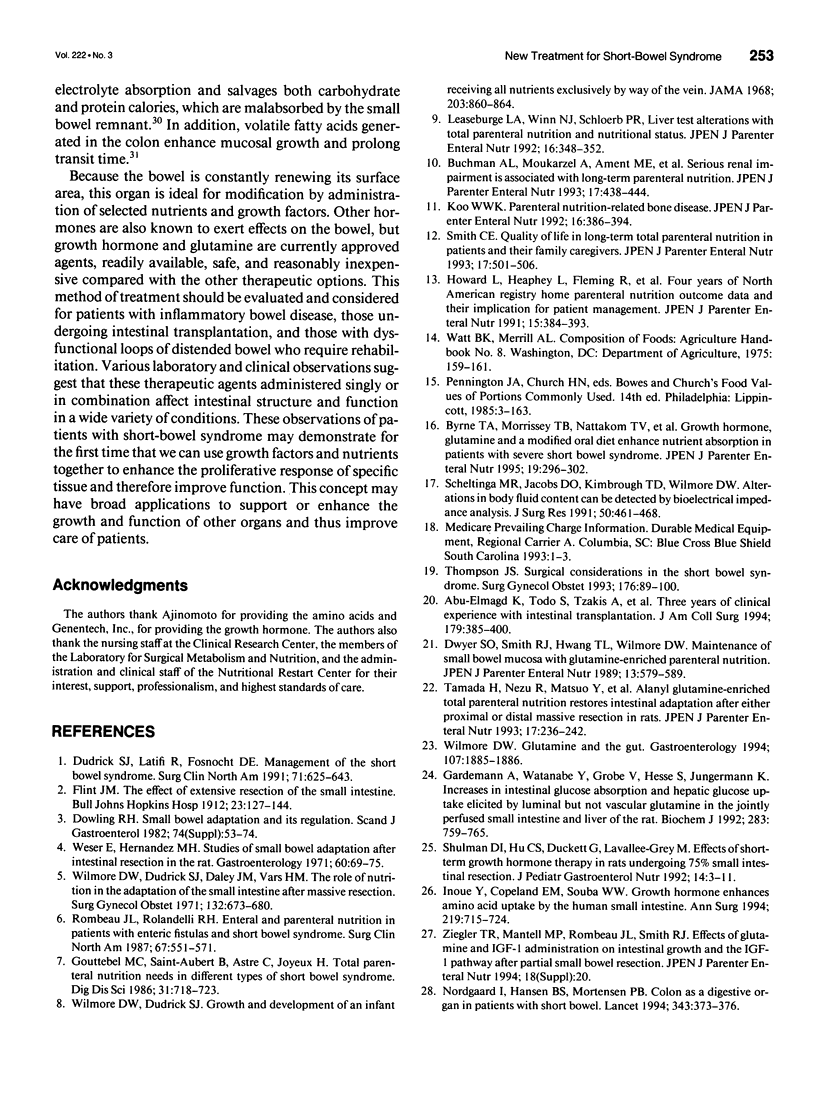

Selected References
These references are in PubMed. This may not be the complete list of references from this article.
- Abu-Elmagd K., Todo S., Tzakis A., Reyes J., Nour B., Furukawa H., Fung J. J., Demetris A., Starzl T. E. Three years clinical experience with intestinal transplantation. J Am Coll Surg. 1994 Oct;179(4):385–400. [PMC free article] [PubMed] [Google Scholar]
- Bond J. H., Currier B. E., Buchwald H., Levitt M. D. Colonic conservation of malabsorbed carbohydrate. Gastroenterology. 1980 Mar;78(3):444–447. [PubMed] [Google Scholar]
- Buchman A. L., Moukarzel A., Ament M. E., Gornbein J., Goodson B., Carlson C., Hawkins R. A. Serious renal impairment is associated with long-term parenteral nutrition. JPEN J Parenter Enteral Nutr. 1993 Sep-Oct;17(5):438–444. doi: 10.1177/0148607193017005438. [DOI] [PubMed] [Google Scholar]
- Byrne T. A., Morrissey T. B., Nattakom T. V., Ziegler T. R., Wilmore D. W. Growth hormone, glutamine, and a modified diet enhance nutrient absorption in patients with severe short bowel syndrome. JPEN J Parenter Enteral Nutr. 1995 Jul-Aug;19(4):296–302. doi: 10.1177/0148607195019004296. [DOI] [PubMed] [Google Scholar]
- Dowling R. H. Small bowel adaptation and its regulation. Scand J Gastroenterol Suppl. 1982;74:53–74. [PubMed] [Google Scholar]
- Dudrick S. J., Latifi R., Fosnocht D. E. Management of the short-bowel syndrome. Surg Clin North Am. 1991 Jun;71(3):625–643. doi: 10.1016/s0039-6109(16)45438-1. [DOI] [PubMed] [Google Scholar]
- Gardemann A., Watanabe Y., Grosse V., Hesse S., Jungermann K. Increases in intestinal glucose absorption and hepatic glucose uptake elicited by luminal but not vascular glutamine in the jointly perfused small intestine and liver of the rat. Biochem J. 1992 May 1;283(Pt 3):759–765. doi: 10.1042/bj2830759. [DOI] [PMC free article] [PubMed] [Google Scholar]
- Gouttebel M. C., Saint-Aubert B., Astre C., Joyeux H. Total parenteral nutrition needs in different types of short bowel syndrome. Dig Dis Sci. 1986 Jul;31(7):718–723. doi: 10.1007/BF01296449. [DOI] [PubMed] [Google Scholar]
- Howard L., Heaphey L., Fleming C. R., Lininger L., Steiger E. Four years of North American registry home parenteral nutrition outcome data and their implications for patient management. JPEN J Parenter Enteral Nutr. 1991 Jul-Aug;15(4):384–393. doi: 10.1177/0148607191015004384. [DOI] [PubMed] [Google Scholar]
- Inoue Y., Copeland E. M., Souba W. W. Growth hormone enhances amino acid uptake by the human small intestine. Ann Surg. 1994 Jun;219(6):715–724. doi: 10.1097/00000658-199406000-00016. [DOI] [PMC free article] [PubMed] [Google Scholar]
- Koo W. W. Parenteral nutrition-related bone disease. JPEN J Parenter Enteral Nutr. 1992 Jul-Aug;16(4):386–394. doi: 10.1177/0148607192016004386. [DOI] [PubMed] [Google Scholar]
- Leaseburge L. A., Winn N. J., Schloerb P. R. Liver test alterations with total parenteral nutrition and nutritional status. JPEN J Parenter Enteral Nutr. 1992 Jul-Aug;16(4):348–352. doi: 10.1177/0148607192016004348. [DOI] [PubMed] [Google Scholar]
- Nordgaard I., Hansen B. S., Mortensen P. B. Colon as a digestive organ in patients with short bowel. Lancet. 1994 Feb 12;343(8894):373–376. doi: 10.1016/s0140-6736(94)91220-3. [DOI] [PubMed] [Google Scholar]
- O'Dwyer S. T., Smith R. J., Hwang T. L., Wilmore D. W. Maintenance of small bowel mucosa with glutamine-enriched parenteral nutrition. JPEN J Parenter Enteral Nutr. 1989 Nov-Dec;13(6):579–585. doi: 10.1177/0148607189013006579. [DOI] [PubMed] [Google Scholar]
- Rombeau J. L., Rolandelli R. H. Enteral and parenteral nutrition in patients with enteric fistulas and short bowel syndrome. Surg Clin North Am. 1987 Jun;67(3):551–571. doi: 10.1016/s0039-6109(16)44232-5. [DOI] [PubMed] [Google Scholar]
- Scheltinga M. R., Jacobs D. O., Kimbrough T. D., Wilmore D. W. Alterations in body fluid content can be detected by bioelectrical impedance analysis. J Surg Res. 1991 May;50(5):461–468. doi: 10.1016/0022-4804(91)90025-h. [DOI] [PubMed] [Google Scholar]
- Shulman D. I., Hu C. S., Duckett G., Lavallee-Grey M. Effects of short-term growth hormone therapy in rats undergoing 75% small intestinal resection. J Pediatr Gastroenterol Nutr. 1992 Jan;14(1):3–11. doi: 10.1097/00005176-199201000-00002. [DOI] [PubMed] [Google Scholar]
- Smith C. E. Quality of life in long-term total parenteral nutrition patients and their family caregivers. JPEN J Parenter Enteral Nutr. 1993 Nov-Dec;17(6):501–506. doi: 10.1177/0148607193017006501. [DOI] [PubMed] [Google Scholar]
- Tamada H., Nezu R., Matsuo Y., Imamura I., Takagi Y., Okada A. Alanyl glutamine-enriched total parenteral nutrition restores intestinal adaptation after either proximal or distal massive resection in rats. JPEN J Parenter Enteral Nutr. 1993 May-Jun;17(3):236–242. doi: 10.1177/0148607193017003236. [DOI] [PubMed] [Google Scholar]
- Thompson J. S. Surgical considerations in the short bowel syndrome. Surg Gynecol Obstet. 1993 Jan;176(1):89–101. [PubMed] [Google Scholar]
- Weser E., Hernandez M. H. Studies of small bowel adaptation after intestinal resection in the rat. Gastroenterology. 1971 Jan;60(1):69–75. [PubMed] [Google Scholar]
- Wilmore D. W., Dudrick S. J., Daly J. M., Vars H. M. The role of nutrition in the adaptation of the small intestine after massive resection. Surg Gynecol Obstet. 1971 Apr;132(4):673–680. [PubMed] [Google Scholar]
- Wilmore D. W., Dudrick S. J. Growth and development of an infant receiving all nutrients exclusively by vein. JAMA. 1968 Mar 4;203(10):860–864. [PubMed] [Google Scholar]
- Wilmore D. W. Glutamine and the gut. Gastroenterology. 1994 Dec;107(6):1885–1886. doi: 10.1016/0016-5085(94)90836-2. [DOI] [PubMed] [Google Scholar]
- Woolf G. M., Miller C., Kurian R., Jeejeebhoy K. N. Diet for patients with a short bowel: high fat or high carbohydrate? Gastroenterology. 1983 Apr;84(4):823–828. [PubMed] [Google Scholar]
- Zamir O., Nussbaum M. S., Bhadra S., Subbiah M. T., Rafferty J. F., Fischer J. E. Effect of enteral feeding on hepatic steatosis induced by total parenteral nutrition. JPEN J Parenter Enteral Nutr. 1994 Jan-Feb;18(1):20–25. doi: 10.1177/014860719401800120. [DOI] [PubMed] [Google Scholar]


